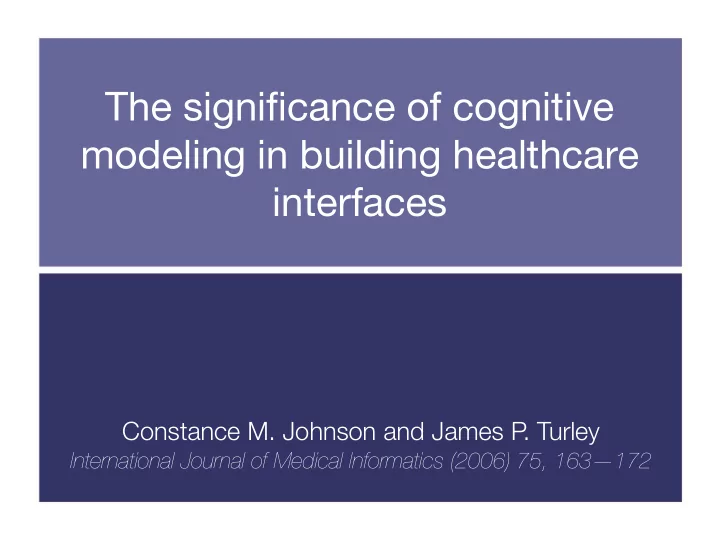

The significance of cognitive modeling in building healthcare interfaces Constance M. Johnson and James P . Turley International Journal of Medical Informatics (2006) 75, 163—172
There is an already emergent need in health care to standardize and promote the EMR (electronic medical record). The EMR has yet to be adopted for a number of reasons: financial expense organizational buy-in technological hurdles deficiency in user-centered interface design Introduction
Though standardization is important, it should not mean simplification in the case of EMRs. Nor should it lead to a one- size-fits-all user interface design. Hypothesis: Different clinician types have different usage patterns and therefore need different interfaces to the data. Introduction
While there is an understanding about the differ- ences between the roles of physicians and nurses, no empirical studies document the differences Note: Isn’t this between physicians and nurses in their understand- exactly what they ing of patients. A review of the literature showed end up saying? that the majority of research on the roles of physi- cians and nurses focuses on their divergent pro- fessional roles as exemplified in the cure versus care paradigm [22,23]. This paper examines the cognitive tasks of the users from a cognitive per- spective. Healthcare users have many different needs, capabilities, and background knowledge. To ensure that the design of healthcare information system matches the tasks of the intended users, we begin with a basic approach of the cognitive task analysis. Introduction
Table 1 Demographics of all subjects Demographics RN MD Male 1 (4%) 18 (75%) 48 clinicians Female 23 (96%) 6 (25%) Average age 45.41 ± 7.45 36.39 ± 10.34 Range 28—60 26—61 24 RN, 24 MD Associates degree 7 (29%) Diploma degree 4 (17%) Bachelors degree 10 (42%) gastrointestinal medicine Masters degree 3 (12%) MD degree 24 (100%) 11.00 ± 10.06 a Average practice 20.62 ± 7.35 English-speaking years 3.58 ± 1.58 b 1—29 a Range 5—32 Number of practice years 1—6 b as delimitation (significance?) a Attendings: physicians in practice. b PGY: resident physicians. Methodology
Three mock cases developed & reviewed, with 12 axes: appendicitis (training), gastroenteritis, pancreatitis demographics, present illness, histories/habits, current medications, allergies, systems review, vital signs, I/O, physical exam, nursing notes, assessment, initial physician orders Think-Aloud technique applied (just what it sounds like) Methodology
Methodology
Original think-aloud monologues were transcribed to MS Word, then separated into sentences, then into “idea units or propositions.” (Text of original cases was also broken down in this way for comparison.) Pattern that emerged after iterative decoding: recalls, inferences, negatives, assumptions, conditionals, interventions, errors/uncoded. Data Collection & Analysis
Examples of coding scheme Table 2 Propositions Code 32.1 He has some tremors Recall 53.1 Patient may simply have Inference gastritis 3.1 She did not have any Assumption surgical history 12.1 Surgical history not given Negative 21.1 If his LFT’s seem to be Conditional increasing then, . . . 59.1 We will get an ultrasound Intervention of the right upper quadrant 5.1 She denies temperature Error/uncoded Data Collection & Analysis
Fig. 2 Mean proportion of proposition types between nurses and physicians. Results
Mean number of propositions between nurses and Fig. 3 physicians. Results
Fig. 4 RN and MD conceptual graph of pancreatitis case. Results
Fig. 5 RN and MD conceptual graph of gastroenteritis case. Results
“Through these coding schemes, we were able to broadly appreciate the differences between how nurses and physicians comprehend a patient problem, and thus successfully complete this cognitive task analysis. The nursing representation of the patient was mainly observational as shown through their large percentage of recalls . The physician representation of the patient was causal as illustrated by their inclusion of a large percentage of inferences . These different patient representations reflect the differences in their respective practice models , whereby nurses are trained to diagnose functional problems and monitor changes in physiological status and physicians are trained to diagnose, manage, and treat patients. Although it is known that the roles of each are different due to their respective practice models, the implications of these differences have not been previously reported.” Discussion
“ Electronic medical records need to be designed to achieve their goals and the goals of the users. Although they all need to contain certain necessary information, the information must be presented in a manner that mimics the thought processes, work routines, and practices of the users. Healthcare is a heterogeneous environment in which there are many different types of clinicians, not all of whom share the same information space. Although the concept of a ‘common information space’ is appealing, it is not practical since nursing and medicine each have different perceptions of the patient.” Implications
Does experience in the field affect the results of the trials? The nurse population was much more experienced on average than the physicians. Would a differently-focused nurse/physician population likely return different results? i.e. non-gastroenterology-related Are there other (more scientific?) methods of measuring cognitive response? Something similar to eye tracking? EEGs? Questions & Issues
Recommend
More recommend